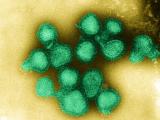Jun 28, 2011 (CIDRAP News) – The price-tag for federal investments in new flu vaccine technology has been difficult to get a handle on, but yesterday in a review for Congress the Government Accountability Office (GAO) put the number at $2.1 billion since fiscal year 2005.
Congress requested the review of federal efforts to support methods to speed and increase the supply of flu vaccine, especially in a pandemic setting, in the wake of production delays for the 2009 H1N1 pandemic vaccine, which was produced by the traditional egg-based method.
Yesterday's flu vaccine report was released along with a separate GAO review of lessons learned during the federal response to the pandemic.
In its 58-page vaccine review the GAO also explored stakeholder development and licensing challenges and how the US Department of Health and Human Services (HHS) is addressing those issues.
Federal investment in new flu vaccine technology comes from HHS as part of its pandemic preparedness efforts and from the Department of Defense (DOD), which includes vaccine development in its military readiness actions. The GAO said HHS investments have covered research and development and production technology, while DOD investments have focused more on production technology.
GAO reviewers covered three alternative flu vaccine technologies in the report: cell-based, recombinant, and dose-sparing with adjuvants.
HHS investments have mainly focused on cell-based technology, which has been the target of about $1 billion, according to the GAO. Two of the six manufacturers that received HHS support—DynPort and Novartis—have completed clinical trials on the path to Food and Drug Administration (FDA) licensure. Novartis hopes to submit its FDA licensing application for a seasonal flu vaccine in 2011, and DynPort projects it will submit its paperwork in 2012, the report said. Other companies are working on cell-based pandemic flu vaccines.
Both HHS and DOD have invested in recombinant flu vaccines, which offer an additional advantage, because they don't rely on sometimes-unpredictable flu virus replication.
The DOD's support for recombinant vaccines has mainly focused on production technology. For example, the GAO highlighted an $86.9 million DOD initiative in fiscal year 2010 called Blue Angel that did not result in a finished 2009 H1N1 vaccine, but produced the first batch of antigen less than 30 days after researchers received information on the virus strain.
Both departments have awarded contracts for the development of adjuvanted flu vaccines. The GAO said two companies that received HHS support are progressing toward FDA licensure, with GlaxoSmithKline anticipating that it will submit its application for an adjuvanted pandemic flu vaccine in 2011 and Novartis estimating that it will submit its application for an adjuvanted seasonal flu vaccine the following year.
In its review, the GAO also interviewed pharmaceutical company and medical association personnel about obstacles to bringing new flu vaccine technologies to market. Though the United States uses more seasonal flu vaccine than any other country, stakeholders said low uptake has dampened companies' desire to develop new seasonal flu vaccines.
Some manufacturers told the GAO that high research and development costs cause manufacturers to shy away from pursuing new flu vaccine technologies, especially in the current economic conditions. HHS said it plans to help manufacturers with research and development by supporting two or three privately owned "Centers for Innovation in Advanced Development and Manufacturing." It said its support for the centers would also help smaller, less experienced companies reduce their costs in developing alternative flu vaccine technologies.
HHS told the GAO that manufacturers are still interested in pursuing new production methods and that its funding efforts are helping to address the difficult investment climate for research and development.
A third obstacle to alternative flu vaccine development relates to regulatory issues such as gaps in the FDA's regulatory science capacity, stakeholders told the FDA. For example, some said the agency has limited staff expertise with the new technologies, which they said makes it difficult to work with the FDA. They also noted that more regulatory science is needed to assess the safety and efficacy of the new vaccines and that current guidance isn't always specific enough to address manufacturers' needs.
FDA officials told the GAO that guidance is intended as a framework, and though the documents are high-level, they can't cover all possible scenarios because some processes are proprietary.
In August 2010 the President's Council of Advisors on Science and Technology (PCAST) addressed pandemic vaccine issues in the light of the 2009 H1N1 experience, and issued a roadmap on how to speed production. It outlined short-term goals such as designing better tests for vaccine potency, but also spelled out longer-term strategies such as moving toward cell-culture and recombinant vaccines.
On the same day the PCAST report came out, HHS released a plan for overhauling the nation's biodefense program, which also addressed pandemic vaccine issues. The plan included $170 million to strengthen regulatory science at the FDA.
See also:
Jun 27 GAO influenza vaccine report
Jun 27 GAO pandemic report
Aug 19, 2010, CIDRAP News story "Obama's science advisors outline plan for faster pandemic vaccine"
Aug 19, 2010, CIDRAP News story "HHS sees greater federal role in building biodefense tools"



















